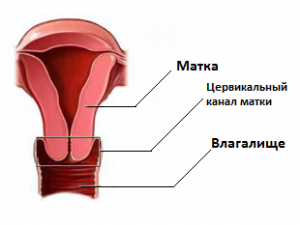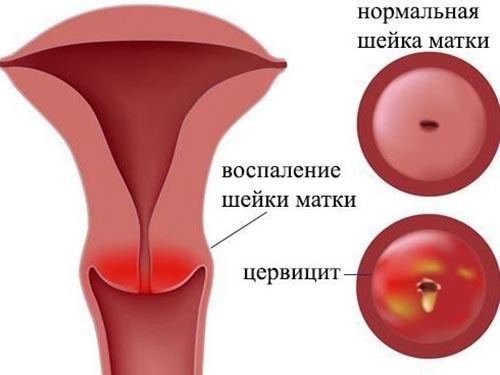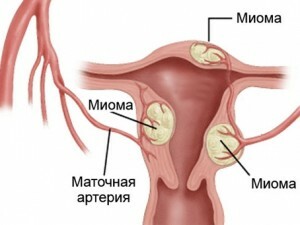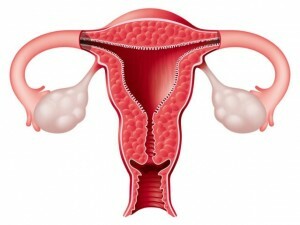Climax is a time of obvious change, which affects the reproductive organs to a greater extent. They are often accompanied by unpleasant symptoms, but in general they are of a natural nature.
However, among these changes may appear strange and undesirable. Not everyone will understand what the expansion of the cervical canal in post-menopause means. After all, before menstruation came, many women did not worry about its size.
Cervical canal - where does it lead?
 The cervical canal is the inside of the cervix, which is the transition between the main female organ and the vagina. It covers a layer of epithelium, which has the ability to secrete mucus. Its number and composition vary, depending on the period of the menstrual cycle.
The cervical canal is the inside of the cervix, which is the transition between the main female organ and the vagina. It covers a layer of epithelium, which has the ability to secrete mucus. Its number and composition vary, depending on the period of the menstrual cycle.
The most liquid and minimal these discharges occur when ovulation, when the body creates the most favorable opportunities for fertilization of the female germ cell. The rest of the time, the mucus is thick enough, and the maximum amount is before the menstrual period.
In women of reproductive age, the cervical canal has a width of 7-8 mm. This is sufficient for the penetration of spermatozoa, the excretion of menstrual excretions, some of which are the secret secreted by its epithelium.
Changes in menopause and cervical channel? The fact that the reproductive system is undergoing changes in this period is already mentioned. Not an exception and this small area. It changes under the influence of a new hormonal balance, like all reproductive organs, that is, it decreases. The reduction of estrogens and progestins is reflected on the uterus in such a way that its muscle tissue atrophies, replacing the connective, vessels narrow. The organ decreases so much that in comparison with what it was before menopause, it becomes one and a half times less. Accordingly, and the dimensions of the cervical canal in menopause are:
- Length 20-25 mm;
- Width of 3-5 mm.
Someone's last value may be even more modest due to the process of tissue infection. Slime thin epithelium also produces significantly less, which in many leads to dryness of the vagina.
The biological meaning of change is clear: a woman no longer threatens to become a mother, therefore, she does not need a passage in the uterus for sperm and menstrual flow.

Changing the cervical channel in menopause is caused by a violation of the hormonal balance
Causes of an enlarged cervical canal
It is necessary to follow gynecological health in the menopause even more carefully than before. This is the time of activation of many diseases, among which are deadly.
Some people find out during the examination that the space leading from the uterus to the vagina is abnormally large. This is already an excuse to worry, because an enlarged cervical canal in menopause means one of the gynecological diseases. The most innocuous of them is the inflammation of the cervical covering.
 Chronic cervicitis sometimes passes unnoticed or with turbid secretions that a woman in menopause may not attach importance to. Promotes the disease of the vagina and uterus, which is characteristic of the period of menopause.
Chronic cervicitis sometimes passes unnoticed or with turbid secretions that a woman in menopause may not attach importance to. Promotes the disease of the vagina and uterus, which is characteristic of the period of menopause. Serosometer
Because of a new hormone that is unusual for the body, the ability to restore the uterine mucosa is impaired. It degrades, which is natural, but this process can be accompanied by the release and accumulation of fluid in the cavity of the organ. And this is not normal.
To stimulate the formation of watery mucous masses in addition to gynecological diseases are capable of:
- Replacement hormone therapy. Most drugs contain estrogens that relieve severe menopause, but can also trigger an adverse event;
- Smoking. Nicotine gums exacerbate hormonal failure, which causes the uterine mucosa to degrade even more;
- Inadequate nutrition, that is, an abundance of fats. They are postponed "in reserve", also increasing hormonal disorder;
- Avoiding physical activity. Afraid of osteoporosis, lazy, a woman minimizes the burden, which further disrupts metabolic processes. This affects the mucous membrane of the uterus in the most negative way.
A woman watches her gray liquid discharge, especially after sex, feels discomfort and pain in the abdomen, difficulty with urination.
Myoma

Myoma of the uterus is one of the reasons for the expansion of the cervical canal in the climax of
. As a rule, myoma is found even before the onset of menopause and delays it for 2-3 years. But for some, this benign tumor appears after ovarian fading, the termination of menstruation.
Promote its appearance at the age of reducing the amount of estrogens:
- Overweight;
- Disorders of carbohydrate metabolism;
- Stresses that are a frequent accompaniment of menopause, especially its first half;
- Pathologies of the thyroid gland, often found in women over 50;
- Past abortions, complicated delivery.
Myoma can also be caused by serosymmetry. If there is an extension of the cervical canal at menopause, watery discharge is seen from time to time, even without blood, it makes sense to do ultrasound and check the thickness of the endometrium. Myoma at this age is often combined with other gynecological pathologies.
Polyp
This benign neoplasm consists of several layers of endometrium that have lingered in one part of the uterus. Races of hormones that occur in premenopause, contribute to its appearance, as well as
- Diabetes;
- Hypertension;
- Obesity;
- Psychological problems;
- Disorders of the thyroid gland.
These causes are manifestations of severe menopause. Therefore, the polyp can also be found in those who had not previously bothered with such a thing. In some cases, he does not hint at himself for a long time. And only when carrying out ultrasound, the specialist will notice both the neoplasm and the enlarged cervical canal.
 We recommend reading the article about the difference between menopause and pregnancy. You will learn about the difference in the composition of hormones produced, the sensations of a woman, the possibility of using a pregnancy test.
We recommend reading the article about the difference between menopause and pregnancy. You will learn about the difference in the composition of hormones produced, the sensations of a woman, the possibility of using a pregnancy test.
Endometrial hyperplasia

Endometrial hyperplasia causes enlargement of the cervical canal
Cervical canal widening may occur in post-menopause due to abnormal growth of cells like endometrium. It would seem that in this period, when estrogens from the body have practically disappeared, this should not be. After all, these hormones, if they are in excess, feed the hyperplastic process.
But the growth of tissues is facilitated by often observed in the climacteric period ailments:
- Increased pressure;
- Overweight;
- Diabetes mellitus;
- Liver diseases.
The use of estrogen-containing drugs that help the body adapt to a new composition of hormones can also increase the risk of an illness.
Hyperplasia can occur secretly or may be caused by bleeding, swelling. Often it is combined with endometrial polyps and cysts. But even with asymptomatic flow it can be found using ultrasound. The endometrium will be thickened, and the space inside the cervix is enlarged.
The expansion of the cervical canal, found in postmenopausal women, can not be ignored. It is a sign of a malaise, which you can get rid of if you do it right away.
In another case, the curable disease can be regenerated into an oncological disease. The more neglected the process, the more problematic the recovery is even after removal of the uterus. You can avoid danger if you do ultrasound of the pelvic organs once a year.

Changing the cervical channel in menopause is caused by a violation of the hormonal balance


Myoma of the uterus is one of the reasons for the expansion of the cervical canal in the climax of
 We recommend reading the article about the difference between menopause and pregnancy. You will learn about the difference in the composition of hormones produced, the sensations of a woman, the possibility of using a pregnancy test.
We recommend reading the article about the difference between menopause and pregnancy. You will learn about the difference in the composition of hormones produced, the sensations of a woman, the possibility of using a pregnancy test. 
Endometrial hyperplasia causes enlargement of the cervical canal
